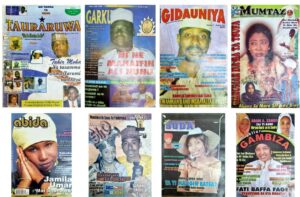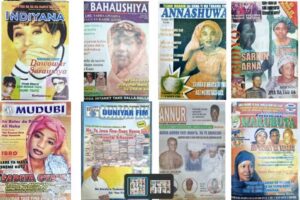

It is a sign of the high value of literature among the Hausa that magazines to cover the new entertainment medium became rapidly established. Even Nollywood, with more Western educated actors and producers, did not produce the volume the magazines the Hausa did with regards to the film industry.
Thus, in the wake of Sangaya’s spectacular success in 1999, Hausa language magazines sprung up to provide news, information and gossip about the Hausa video film industry soon after the industry started to crystallize. However, the first Hausa video film magazine, Taskira was established in 1996 in Kano, but ceased publication after few issues. Its place was taken by a more successful Tauraruwa (“Star” and inspired by the Hindi film magazine, Stardust, which was extremely popular in urban Hausa northern Nigeria) established by a writer and filmmaker, Sunusi Shehu Burhan which was introduced in 1998 to capture the burgeoning Hausa video film scene. Sunusi, an avid Hollywood and Hindi film enthusiast, coined the term Kanywood for the Hausa video film industry in August 1999 — creating an indigenous label for the industry two years before The New York Times created Nollywood for the Nigerian film industry in 2001. In that period, well over 80% of the production studios as they existed, were located in Sabon Titi, Kano, a wide street that bisected Kano city. Tauraruwa magazine pitched its single office in the area which rapidly became known as “Kanywood Boulevard”.
In March 1999 Fim magazine debuted. Published in Kaduna, it remained the single most consistent source of information about the industry since its first issue. Professionally produced, with an almost academic flair for balance and less sensationalism, it rapidly became the leading and authoritative Hausa video film magazine in Nigeria and beyond, complete with an independent web site (and prefers to use Kaliwud initially instead of Kanywood for the industry, although the industry, in solidarity with Sunusi Shehu who coined the term, prefers Kanywood).
Later, the longevity and tenacity of Fim magazine standardized the coinage to Kannywood from 2002, propelling it into Oxford English Dictionary in 2019 which defines it as “The Nigerian Hausa-language film industry, based in Kano; Kano regarded as the centre of this industry”.
Other magazines that joined in the fray included Annashuwa, Bidiyo, Duniyar Fim, Garkuwa, Gidauniya, Indiyana, Majigi, Marubuciya, Mudubi, Mujallar Sharhi, Mujallar Sho, Mumtaz, Nishaɗi, Sharhin Fim, Shirin Fim, and Tauraruwa. Like the Hausa video film industry itself, competition to establish the magazines, with the exception of the sole survivor, Fim, was motivated by a do-it-yourself journalism ethos and desire to make money, rather than to document the process. This explains why out of about 16 titles established between 1998 to 2005, only one, Fim, survived.
A study of their lifespan indicated varying longevity from just one issue (Mujallar Sharhi), to two (Annur, Sharhin Fim, Indiyana) or four to six (Annashuwa, Majigi, Marubuciya). The rest survived few issues beyond number 10 up to 2004 before folding up.
Indiyana became somewhat unique in that it provided news and information in Hausa about Hindi, rather than Hausa, film industry—which it culled from Hindi film magazines like Fanfare and Stardust, as well as Internet web sites. However, after only two issues, it folded up.
Marubuciya started as a literary magazine, but started to focus on the burgeoning Hausa video film industry after three issues to get a share of the market. Increasing availability of printing presses created more varieties of covering the entertainment industry. Thus, Nishaɗin Mako became the first (18th to 25th September, 2003) initially fortnightly newspaper to cover the industry. It ceased production after that one issue.
The magazines are almost exclusively devoted to video films, trying to keep pace with their rapid expansion, highlighting the appeal of particular films and expanding the number of stars and superstars in the process. And perhaps not surprisingly, regular contact and coverage of the industry provided the magazine publishers with video ideas; for they too entered the video film production business. Thus, Fim magazine produced Gagarabadau, Daren Farko and Artabu, while Majigi (through Shalamar Video film studio in Abuja) produced Honarabul, Illar Gaba and Nafisa–Ta.
Beside the magazine as vehicles of a media process, new linguistic terms rapidly appeared which became the lexicon of the industry, essentially introduced by the younger spectrum of the business, and reflected their globalized adaptation of English words to Enghausa. Thus, some of the popular terms that emerged included shutin (shooting), lokashin (location), artisaye (set rehearsals), industiri (industry), kastin (casting) sina-sinai (scenes), selinface (selling face), rol (role), camama (low budget, i.e., cheaply, produced videos, popularized by Ɗan Ibro franchise), Kan-ta-waye (rookie, greenhorn, fresh Executive Producer, especially a woman with more money than sense, to produce a film). They reflect the new lexicon of Hausa urban film folk and sophisticates.
Indeed, as shown by Yusuf Adamu, a whole new videospeak language, bulungudu was created principally by a seasoned actor, Hussaini Ƙoƙi in 1994. This new created language was first used in Qarni, a film by Hafizu Bello in collaboration with Abba Lawan in 2003. Bulungudu echoes the Klingon language, known as Klingonese or tlhIngan Hol, which was first introduced in “Star Trek: The Motion Picture” in 1979.
By 2005 the Hausa video film had established itself as a perfect example of globalization of popular culture in a traditional society. The darkness fell in the noon of 2007 with a private phone video clip.





